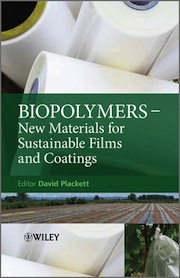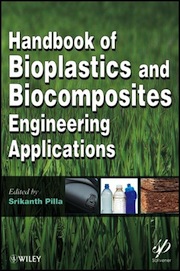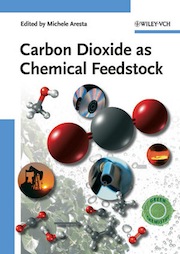In this review two new books on bioplastics and one on carbon dioxide as a chemical feedstock are introduced. All are published by Wiley in 2011.
 David Plackett (ed.; 2011): Biopolymers – New Materials for Sustainable Films and Coatings. Wiley-VCH, Weinheim. 334 pages, ca. 102,- Euro. ISBN 978-0-470-68341-5.
David Plackett (ed.; 2011): Biopolymers – New Materials for Sustainable Films and Coatings. Wiley-VCH, Weinheim. 334 pages, ca. 102,- Euro. ISBN 978-0-470-68341-5.
This book covers the development and utilization of bio-based polymers and focusses on film and coating applications. It concentrates on the technical description of the production and the properties of selected bio-based polymers mainly used als films and coatings in food packaging, paper coating, agricultural films and edible coatings. In the first part on the diffenerent polymers it starts with the characterisation of starch-based polymers and blends after a short introduction on worldwide markets and sustainability. The next chapters concentrate on the production, chemistry and properties of polylactides (PLA), polyhydroxaalkanoates (PHAs), Chitosan and protein-based polymers, hemicelluloses, cellulose-based materials and furane polymers. The second part describes the applications and starts with chapters on the use of bio-based polymers for food packaging applications and edible films and coatiungs in food applications. After these, technical applications like coatings for paper and paperboards, biopolymer films in Agriculture and films and coatings for advanced applications like optoelectronics and sensors are described, followed by a summary with future perspectives. All in all it gives a very good insight in the use of films and coatings from bio-based polymers for technicians as well as for other interested experts. Srikanth Pilla (ed.; 2011): Handbook of Bioplastics and Biocomposites. Engineering Applications. Wiley-VCH, Weinheim. 588 pages, ca. 156,- Euro. ISBN 978-0-470-62607-8.
Srikanth Pilla (ed.; 2011): Handbook of Bioplastics and Biocomposites. Engineering Applications. Wiley-VCH, Weinheim. 588 pages, ca. 156,- Euro. ISBN 978-0-470-62607-8.
This handbook covers the use of bioplastics and biocomposites on mainly five areas of technical applications: The packaging sector, civil engineering, biomedical uses, automotive and general engineering. For this reason it brings together articles from the academia working in the field of research and development of bio-based materials as well as from the industry. It is written for engineers, scientists and researchers in all these areas as well as for experts from the industry and other interests. The structure mirrors the five sectors, after a general introduction on biopolymers and biocomposites by the editor Srikanth Pilla, professor at the University of Wisconsin-Madison, USA, and an overview on processing of biopolymers and biocomposites. After these several articles from different authors give a concentrated overview on different topics concerning the uses in the main applications as well as on biogenic raw materials and monomers. Michele Aresta (ed.; 2011): Carbon Dioxide as Chemical Feedstock. Wiley-VCH, Weinheim. 414 pages, ca. 138,- Euro. ISBN 978-3-527-32475-0.
Michele Aresta (ed.; 2011): Carbon Dioxide as Chemical Feedstock. Wiley-VCH, Weinheim. 414 pages, ca. 138,- Euro. ISBN 978-3-527-32475-0.
The third book in this review covers a totally different field, the use of CO2 as a feedstock for the chemical industry. It investigates the use of CO2 for ureas, enzymes, carbamates, and isocyanates, as well as its use as a solvent, in electrochemistry, biomass utilization and much more. It is written as a comprehensive source for every synthetic chemist in academia and industry. It covers the whole chemistry of CO2 as well as the option to reduce its accumulation in the atmorsphere by utilization for the chemistry. Beside this its focuses are catalytic and chemical processes to use CO2. In the field of the use of renewable raw materials it covers the utilization of terrestrial and aquatic biomass for 2nd generation biofuels and biorefineries (via gasification) as well as the autotrophic carbon fixation in biology and different options of fermentation of CO2 via different metabolistic pathways.
Source
Wiley, 2011-09-05.
Supplier
Share
Renewable Carbon News – Daily Newsletter
Subscribe to our daily email newsletter – the world's leading newsletter on renewable materials and chemicals










